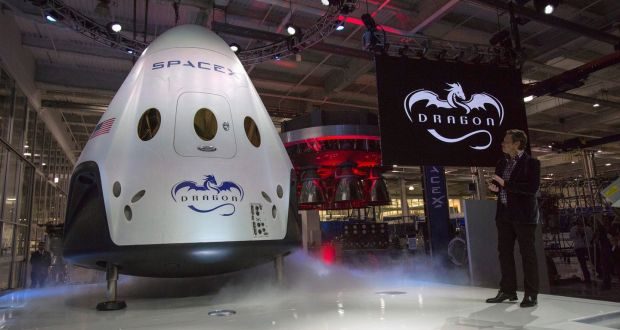Musk’s aerospace company SpaceX announced Monday it’s accepted a “significant deposit” from two private citizens to take a trip around the moon in late 2018. The two space tourists are expected to begin training and undergo health and fitness tests later this year.
According to Reuters and the Los Angeles Times, the proposed orbital flight would be 100% self-funded, would take place in late 2018 (roughly 45 years after the last Apollo mission) and would use the Falcon Heavy booster rocket – which, it should be noted, has yet to be flown.
SpaceX founder/chief executive Elon Musk announced his company’s plans during a conference call with the media on Monday, but did not provide details about the cost of the mission. He also said that two people had approached him about arranging the voyage, but he declined to identify them, saying only that they had already put down a deposit and were “nobody from Hollywood.”
The journey would take about a week and would be similar to NASA’s 1968 Apollo 8 mission, said Reuters. It would travel between 300,000 and 400,000 miles (480,000 to 640,000 km) from Earth past the moon before gravity pulled the spacecraft back into the planet’s atmosphere for a parachute landing, the news organization added.
It’s an ambitious plan, but can they really pull it off?
Musk said that the cost of the mission will be completely covered by the anonymous passengers, according to the Times. He said that the deposit they had already paid was “substantial” and that they would begin “extensive training” and “fitness tests” sometime later on this year.
The SpaceX CEO went on to say that he believed there is “a market for one or two of these” kind of flights each year, and that such space tourist fees could eventually make up as much as 20% of the company’s revenue. Musk also said that he wanted to position SpaceX so that it would be the first aerospace firm called upon in the event that NASA plans their own return to the moon.
During the call, Musk said that the proposed lunar tourism project “should be a very exciting mission that hopefully gets the world really excited about sending people into deep space again.” He also emphasized that NASA “would have priority in any lunar mission, [but] in the absence of that, it would just be two private individuals on board.”
In a statement sent to the Times on Monday, NASA said that it “commends its industry partners for reaching higher” and promised to work closely with SpaceX to ensure that it “safely meets” its contractual obligations for transporting astronauts and supplies to the space station. While the firm will need to obtain a launch license from the Federal Aviation Administration before it can lift off, reports indicate that there are no other regulatory hurdles for it to overcome.
Lori Garver, who served as deputy administrator of NASA during the Obama administration, told the Washington Post that she was skeptical that SpaceX could pull off such a flight by the end of next year, but said it would be “fantastic” if they could do so by 2020. “It would show that we, in this country, are still in space, and innovating and exploring and capturing the excitement that we have,” she told the newspaper. “I think it would be very positive.”
Agencies/Canadajournal
 Canada Journal – News of the World Articles and videos to bring you the biggest Canadian news stories from across the country every day
Canada Journal – News of the World Articles and videos to bring you the biggest Canadian news stories from across the country every day



